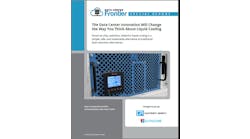State of the European Data Center Market
In this edition of Voices of the Industry, Eric Boonstra, VP & GM of Iron Mountain Data Centers Western Europe explores how the European data center market is evolving and poised for future growth.
Eric Boonstra, VP & GM of Iron Mountain Data Centers Western Europe
As I write this article, the data center industry feels more global than ever. For those that call colocation their trade, it is exciting to look at the opportunity in front of us and the roles we will all play in changing the world as we know it.
2017 set industry records for capital investment and acquisitions and 2018 has kept the trend going with a material percentage coming from markets outside the United States. We see the largest players in colocation pushing the boundaries of their portfolio beyond the comfort zones of North America, developed EU markets, and top-tier regions in Asia Pacific to places like the Middle East, Africa, South America, and India amongst others. Hyperscale data center consumers are either following suit or driving the trend depending on your perspective.
The globalization of colocation is something that I have experienced recently as the former CEO of EvoSwitch , now Vice President & GM, European Markets for Iron Mountain Data Centers. EvoSwitch NL was acquired in May of 2018 for $235M. Our goal with the transaction was to team up with a company like Iron Mountain with operations in 54 countries, 225,000+ customers, and more than 85 million square feet of secure real estate in order to scale our successes and vision to new customers and markets outside Amsterdam. We now have operations in three continents and more than 2.5 million square feet of data center space under management.
So, in the spirit of data center globalization, I would like to present a snapshot of the Western European data center market to help drive awareness as we all come closer together.
Top EU Markets, Growth
The top data center markets in Europe can be found where the largest Internet exchanges reside – the FLAP markets – Frankfurt, London, Amsterdam and Paris. The London Internet Exchange or LINX, DE-CIX in Germany, and AMS-IX in the Netherlands are all world-class peering exchanges with hundreds of the largest networks exchanging huge volumes of traffic.
According to the 451 Research 2017 Global Multi-Tenant Data Center Report, the FLAP markets are four of the top 20 global markets, with London as the largest EU market, second to only Northern Virginia in terms of total square feet of capacity. While the FLAP markets are the foundation of the EMEA data center landscape, the markets are growing at a 12% CAGR, a full 4% higher than the established markets.
In terms of global colocation revenue, 451 Research data ranks EMEA third to the US and APAC with a 19% share. However, according to CBRE, the first half of 2018 has been a record-breaking stretch in terms of both new supply and market demand for Western Europe. The real estate firm cites 95 MW of capacity delivered in 2018 with another 82 MW potentially to be added before the year is finished.
The Metropolitan Region Amsterdam (MRA) is a critical node in the FLAP data center market, which totaled approximately MW at the end of 2017. The MRA experienced net absorption of more than 21 MW of space in the fourth quarter of 2017. As earlier, the Amsterdam Internet Exchange (AMS-IX) is one of the world’s leading points of peering, and the MRA boasts the lowest average energy prices and the most reliable energy grid among FLAP markets.
EU Mergers and Acquisitions, Drivers of Data Center Demand
Mergers and acquisition (M&A) activity in Europe continues to be strong as large colocation providers look to expand domestic offerings to major global markets in a race to interconnect the globe. Iron Mountain’s acquisition of EvoSwitch NL was not the only deal that made international news. Other significant transactions included the $442M Zenium/CyrusOne transaction, AXA IM/DATA4, and GTT’s acquisition of Interoute for $2.3 billion. Iron Mountain also acquired a Credit Suisse data center in London Slough to bolster its growing EMEA presence as well as inSingapore. Investment is being focused in the FLAP markets, Dublin, Madrid, and Nordic countries.
As with most of the high-growth markets, EU is experiencing significant demand from hyperscale data center consumers such as public cloud providers and large Internet businesses. A new trend is an increase in demand from Chinese hyperscalers and telcos as they look to complete their global networks. With the onset of the General Data Protection Regulation (GDPR), there is an increase in country-localized data centers to ensure data does not cross country borders.
Challenges in the European Data Center Market
The European data center market presents a plethora of business challenges when compared to the United States. To start, there are 23 officially recognized languages spoken across Europe. Though not as big of an issue in Western Europe, there are 28 different currencies, with the most common of course being the Euro. This can cause complications with contracting and multi-national product pricing. In Amsterdam, though, almost everyone speaks English, which makes it an easier place to do business. Regulations are different with regard to data center construction, operations and even human resources. We also face issues with borders and data sovereignty. The GDPR has added complexity and liability to data management. From the data center design perspective, Europe also has less space to build than many locations, so we must be creative in data center design. Power grid availability also tends to be a challenge in Europe.
The European data center market presents a plethora of business challenges when compared to the United States.
Sustainability
European regulations are more intense when it comes to environmental sustainability as compared to the U.S. Fortunately for Iron Mountain, when we started EvoSwitch NL, our team had the foresight and commitment to only buy green, renewable energy from wind and water. AMS-1 is powered by 100% renewable energy and offers extremely high-energy efficiency and a low PUE number, addressing current regulations.
It is my belief that end user demand for green data center services is also higher in EU markets. Companies take their environmental responsibility seriously and pursue real goals and accountability metrics when it comes to carbon footprint. The good news is, the cost of wind energy has dropped significantly leading to more investment by colocation providers and more clean capacity.
It is a win-win-win. Good for the customer. Good for the colo provider. Good for the environment.
The Race to Connect the Globe
As market consolidation continues, differentiation may be found more in international operations, connectivity and integration efficiency as opposed to product-based innovation. A specific example is how colocation providers in London react to BREXIT and the resulting complexities. The good news is key components will stay the same from continent to continent – hyperscale demand driving new market entry and their wholesale requirements.
Sooner than later we will be talking about ubiquitous global IT resources delivered from colocation facilities and edge data centers in every corner of the world. Regulations and political limitations in markets like China and India have to be . And, the proliferation of data and the resulting intelligence will help to make this planet smaller, tying us all together via massive network pipes built to move large data volumes in an attempt to address the exponential growth of machine and end-user generated data.
One thing is for sure, the EU data center market will be at the center of it all as a critical relay point tethering North America and South America to the Middle East and Asia.
Eric Boonstra, VP & GM of Iron Mountain Data Centers Western Europe.





